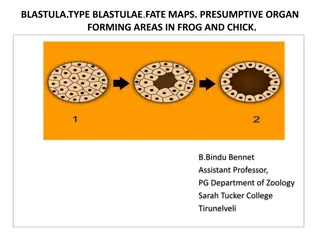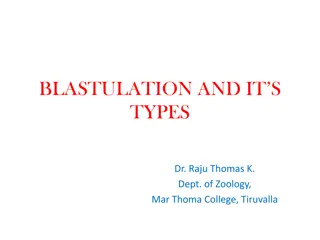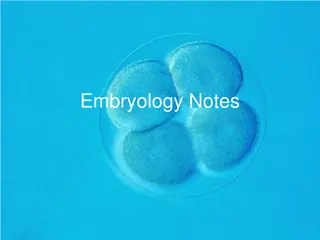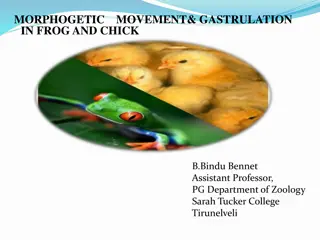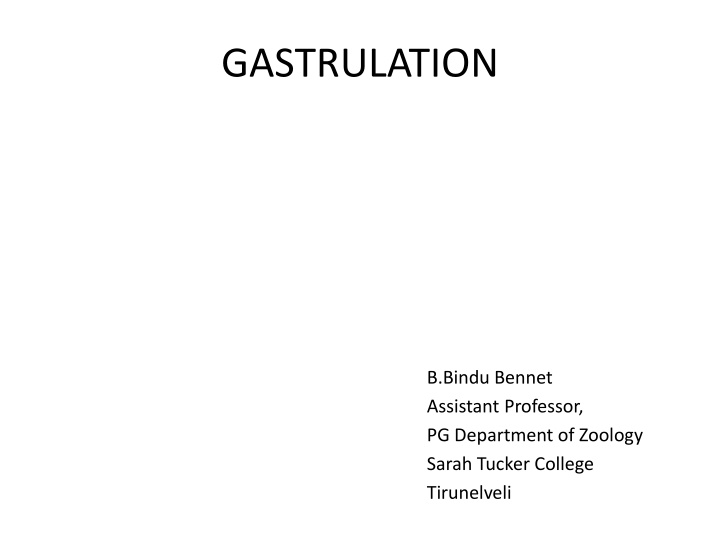
Understanding Gastrulation: Key Concepts and Significance
Gastrulation is a crucial phase in embryonic development where the blastula transforms into a multilayered gastrula. This process establishes distinct cell lineages and body axes, internalizes cell types like the gut, and forms the three germ layers: ectoderm, mesoderm, and endoderm. Mesoderm gives rise to various cell types in vertebrates, while cells organize into epithelia or mesenchyme post-gastrulation. Common features include changes in embryo structure, cell differentiations, and digestive functions. Despite variations, gastrulation is unified by five fundamental cell movement types.
Download Presentation

Please find below an Image/Link to download the presentation.
The content on the website is provided AS IS for your information and personal use only. It may not be sold, licensed, or shared on other websites without obtaining consent from the author. If you encounter any issues during the download, it is possible that the publisher has removed the file from their server.
You are allowed to download the files provided on this website for personal or commercial use, subject to the condition that they are used lawfully. All files are the property of their respective owners.
The content on the website is provided AS IS for your information and personal use only. It may not be sold, licensed, or shared on other websites without obtaining consent from the author.
E N D
Presentation Transcript
GASTRULATION B.Bindu Bennet Assistant Professor, PG Department of Zoology Sarah Tucker College Tirunelveli
Definition of gastrulation Definition of gastrulation Gastrulation is a phase early in the embryonic development of most animals, during which the single-layered blastula is reorganized into a multilayered structure known as the gastrula. Before gastrulation, the embryo is a continuous epithelial sheet of cells; by the end of gastrulation, the embryo has begun differentiation to establish distinct cell lineages, set up the basic axes of the body (e.g. dorsal-ventral, anterior- posterior), and internalized one or more cell types including the prospective gut. In triploblastic organisms the gastrula is trilaminar ("three- layered"). These three germ layers are known as the ectoderm, mesoderm, and endoderm.[1][2]In diploblastic organisms, such as Cnidaria and Ctenophora, the gastrula has only ectoderm and endoderm.
The mesoderm gives rise to many cell types such as muscle, bone, and connective tissue. In vertebrates, mesoderm derivatives include the notochord, the heart, blood and blood vessels, the cartilage of the ribs and vertebrae, and the dermis.
Following gastrulation, cells in the body are either organized into sheets of connected cells (as in epithelia), or as a mesh of isolated cells, such as mesenchyme.
However, some common features of gastrulation across triploblastic organisms include: (1) A change in the topological structure of the embryo, from a simply connected surface (sphere-like), to a non-simply connected surface (torus-like); (2) the differentiation of cells into one of three types (endodermal, mesodermal, and ectodermal); and (3) the digestive function of a large number of endodermal cells.
Although gastrulation patterns exhibit enormous variation throughout the animal kingdom, they are unified by the five basic types of cell movements that occur during gastrulation: 1) invagination 2) involution 3) ingres sion 4) delamination 5) epiboly
Gastrulation occurs when a blastula, made up of one layer, folds inward and enlarges to create a gastrula. This diagram is color- coded: ectoderm, blue; endoderm, green; blastocoel (the yolk sack), yellow; and archenteron (the gut), purple. Blastula.png
MORPHOGENITIC MOVEMENT MORPHOGENITIC MOVEMENT Morphogenesis (from the Greek morph shape and genesis creation, literally, "beginning of the shape") is the biological process that causes an organism to develop its shape. It is one of three fundamental aspects of developmental biology along with the control of cell growth and cellular differentiation, unified in evolutionary developmental biology (evo-devo). The process controls the organized spatial distribution of cells during the embryonic development of an organism. Morphogenesis can take place also in a mature organism, in cell culture or inside tumor cell masses. Morphogenesis also describes the development of unicellular life forms that do not have an embryonic stage in their life cycle, or describes the evolution of a body structure within a taxonomic group. Morphogenetic responses may be induced in organisms by hormones, by environmental chemicals ranging from substances produced by other organisms to toxic chemicals or radionuclides released as pollutants, and other plants, or by mechanical stresses induced by spatial patterning of the cells.
MORPHOGENITIC MOVEMENT MORPHOGENITIC MOVEMENT gatrulation involves mass movement of cells commonly known as morphogenitic movements. morphogenitic movements defined as displacement of masses of cells in embryonic development of animals, particularly conspicuous during gatrulation. Morphogenetic movements change the organization of the embryo by changing the shape of cells as well as the groups of cells of the embyo.
GASTRULATION IN FROG Gastrulation in frog is accomblished by four methods and all these processes take place simultaneously. These methods are as follws : 1.Modified invagination (or emboly) 2. Involution (or inflection) 3. Epipoly (or overgroth) 4. Convergence.
MODIFIED INVAGINATION MODIFIED INVAGINATION (or emboly) The begining of gastulation is marked by the formation of a transverse notch halfway between the vegetal pole and the equater, where the plastomeres of the animal and vegetal pole merge with one other . This transverse notch gradually increases in size and becomes crescent shaped. This is the indication and beginnig of modified invagination in frog.
INVOLUTION (or inflection) This is perhaps the most vital process in the gastrulation of frog . The blastomers at the dorsal lip of the blastopore ,roll inside ,or turn inside and arrange themselves on the roof, sides and the floor of the newly formed archenteron. Simultaneously with this the archenteron also widens and deepens and this in turn would gradually obliterate the blastocoel.
EPIPOLY (or overgrowth) The blastomeres in the animal pole have the tendency to overgrowth the yolk cells this is called epipoly . Which is are accessory process, and is usefull in the accomplishment of gastrulation . The blastomeres of the animal pole proliferate and over growth the yolk cells except at the region , where the dorsal lip of the blastopore is formed .
CONVERGENCE This is also an accessory process, and can be seen in the gastrulation of frog. During this process is a steaming of the materials of the material s of the dorsal and the lateral surfaces of the early gastrula towards the region of the blastopore.
GASTRULATION IN CHICK Gastrulation in chick is an active and dynamic process as in branchiostoma and frog. The methods by which gastrulation is accomplished are dependent on the amount of yolk present in the ovum. 1.Formation of hypoblast 2.Formation of primitive streak 3.Epipoly
FORMATION OF HYPOPLAST The appearance of a second cell layer with in the subgerminal cavity marks the beginning of gasrulation. This second layer which is thus formed is the primitive hypoplast. Now the space underlying yolk is termed the archenteron. 1.Infilteration method 2.Delamination
FORMATION OF PRIMITIVE STREAK The epiblast cells of area pellucida from the posterior part migrate into the middle line and become aggregated in the middle line to form a longitudinal thickening of the epiblast cells in the area pellucida is called the primitive streak .
EPIPOLY Epiboly is also found in gastrulation of chick.the various area of blastoderm ,area vasculosa ,area vitelina, etc. Gradually overgrowth the yolk till the later is completely enveloped. Thus the gastulation in chick , involves hypoblast formation by infilration or by delamination . Primitive streak formation by convergence and epiboly or over growth.

